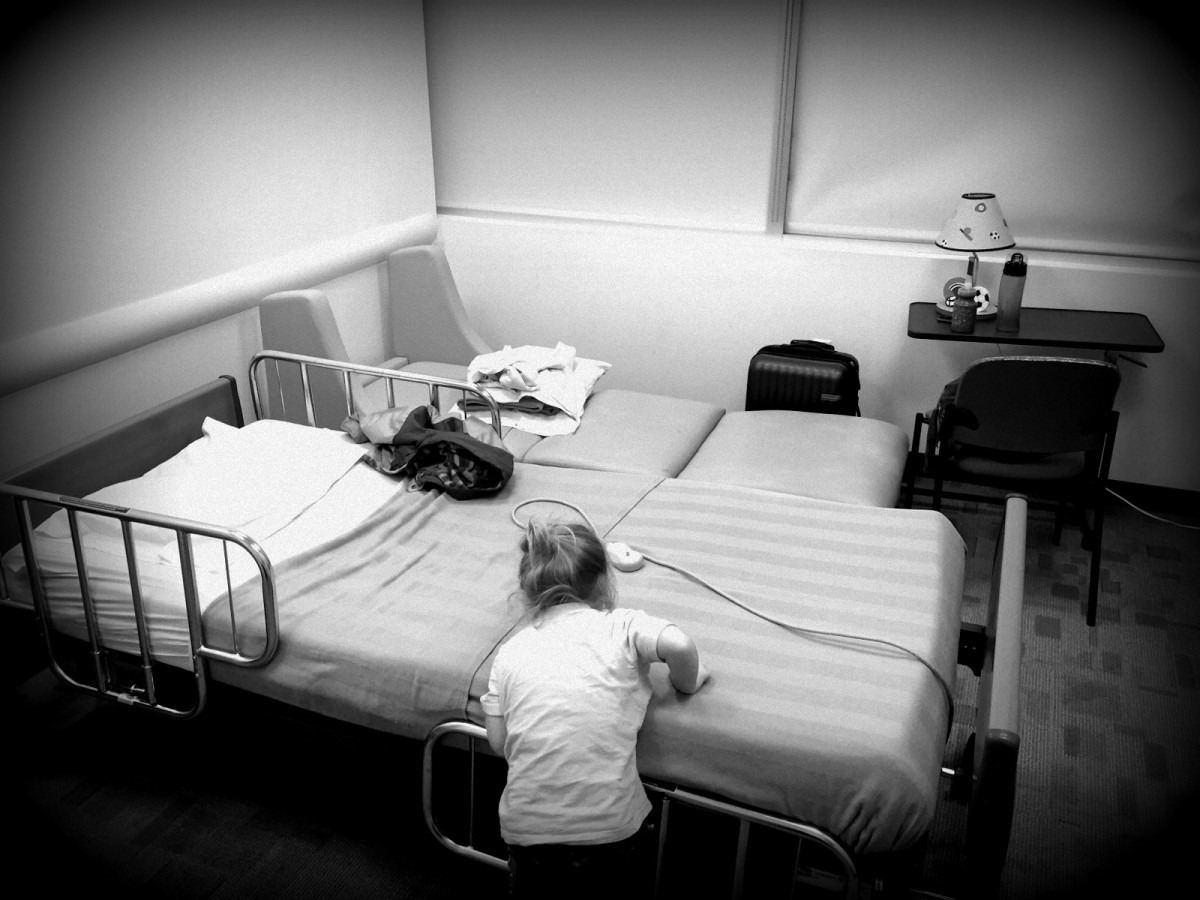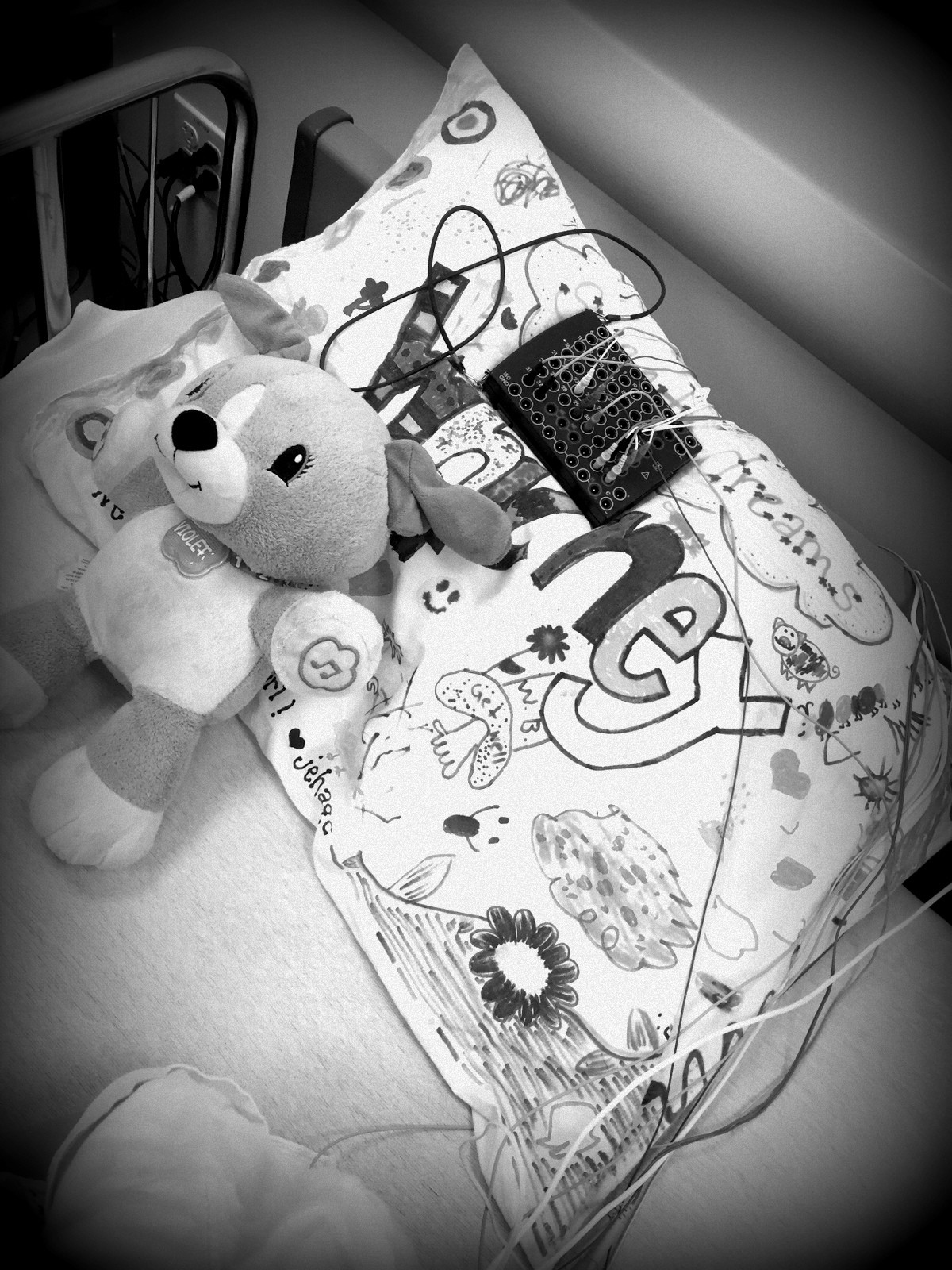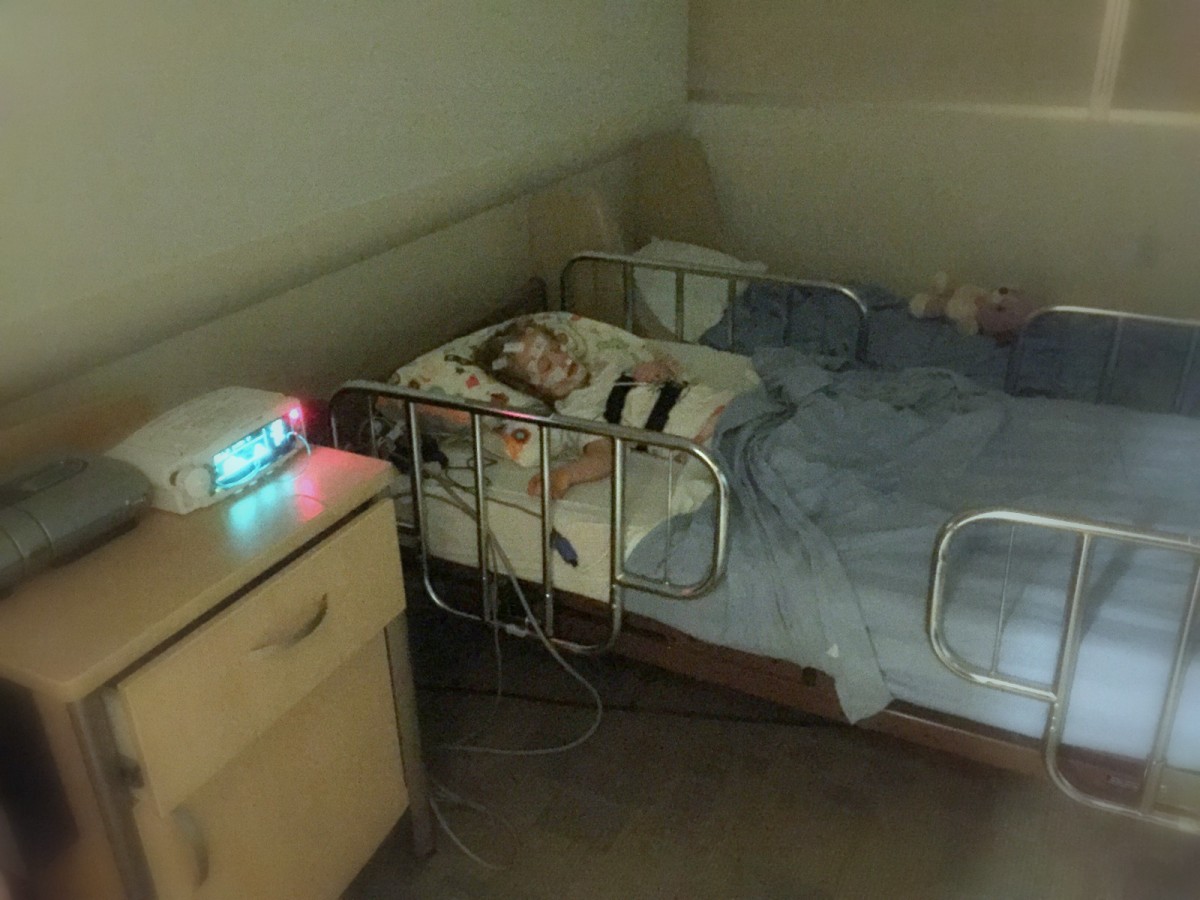Sleep Study: how we figured out our baby had sleep apnea
I always thought Whitney was a good sleeper. She slept through the night when only a few months old, she would sleep soundly even amidst moderate noise and light. Sometimes she snored, but not crazy loud and never with snorts or gasps, it was more of a cute snore and usually it seemed to coordinate with being congested from a cold. She was pretty good at going down for naps and would sleep 10-12 hours each night, waking up sweet and happy.
A year ago (when she was 3 1/2) as my husband or I lay down with her during sleep times we noticed that sometimes there would be a long pause after she exhaled before she’d breathe in again. When I brought it up with her ENT he suggested a sleep study. He didn’t really ask me many questions about it, and I had brought up her sleep just to consider what to be looking for, not really thinking something was wrong but that maybe I should be looking out for anything concerning. I got the impression he was just willing to go along with an prescribe anything based on even my slightest question or concern. I scheduled a sleep study but in the meantime listened more carefully and ended up cancelling the study because it just didn’t seem like her sleep was being compromised. It didn’t sound abnormal, and it seemed that my original questions about her sleep were related to a time when she was congested with a cold.
Fast forward to a few months ago…her ears had been chronically full of fluid throughout the fall which compromised her hearing and she was failing hearing tests. She had gotten tubes put in her ears for fluid at about 9 months old and they lasted about a year before falling out. The ENT (a new one) recommended a second set of tubes, which we agreed with. She also talked with us about considering other reasons Whitney may have fluid in her ear. Ear infections are not unusual for babies and toddlers, but as kids age, their ear anatomy changes in a way that prohibits fluid from pooling up in the ear canal. For kids with Down Syndrome, these changes don’t always alleviate fluid problems since it is common to have very tiny ear canals and ones that angle in such a way to make drainage more difficult. I had hoped that being close to 5 years old would mean Whitney would be “growing out” of ear fluid and infections, but that wasn’t the case, and so I figured perhaps her ear anatomy would just take longer to adjust to deal with fluid more efficiently. The ENT explained that the adenoids (lymphatic cells in the back of the nose/throat) may be enlarged or blocking fluid from draining properly. I had heard of many cases where kids with Down syndrome get their adenoids removed (or “melted away” as I learned), it’s a fairly simple procedure with a minimal recovery. We were on board to have the ENT take a look at her adenoids at the time of her tube surgery and take care of them as needed. Seemed like enough to me. But then, she saw in our records we can considered a sleep study in the past (not at all on my mind at that point). She inquired further about Whitney’s sleep and after thinking about it again I realized that ever since getting back from Colorado (6 months ago), she had been waking up in the middle of the night most nights and crawling in to bed with us. I sort of figured it was a behavioral thing, or just a factor of being sick off and on, or waking up during a certain part of her REM cycle and realizing she could come find us – because who doesn’t love sleeping with their mommy and daddy? I still didn’t think she snored or stopped breathing (gasping) or anything odd, but Tyler thought maybe she sometimes took abnormally long breaths or was irregular at times. The ENT assured us that waking up each night at her age was not normal (especially after having slept through the night so consistently for most of her life). She also explained that it’s not uncommon around this time for ENT anatomy to change in such a way to have an onset of sleep problems. AND, she explained that a sleep study is actually a recommended procedure for kids with Down syndrome based on the American Academy of Pediatrics because the incidence of obstructive sleep apnea is so high among people with Down syndrome (50-75%). It is a recommended procedure? I guess it had been a while since I had looked at that list. Guilty mama setting in, and we rush scheduled a sleep study to see if there was apnea and potentially a need to remove the tonsils (which would ideally be done when doing tubes/adenoids…once you’re in there under anesthesia, take care of everything).
So, if your child has Down syndrome and anything at all indicating that sleep might be anything less than ideal (or just because it’s recommended) – schedule a sleep study.
The Sleep Study
I went with Whitney to the sleep study. It was interesting. They hooked her up with all sorts of tubes and wires, and she did sleep! Apparently kids almost always do get sleep – or enough to get sleep data for them. There’s a little room with an infrared camera where a technician watches her and the monitor that she’s hooked up to all night. My fold out “bed” was right next to hers (admittedly creepy to know you’re being watched all night). When we arrived Whitney happily crawled right up into the bed that would be hers (no surprise because she’s often intrigued by other people’s rooms/beds when we visit our friends and would gladly climb up in a bed with a book and hang out).
My happy girl is not phased by new or different experiences. We brought along a few toys and books from home and she was happy as ever.
Here’s the port that all her sensor wires hooked into. It sat on the table next to her bed all night.
And here she is all hooked up! A mess of wires on various parts of her body and mostly on her face and mixed into her hair (what a goopy mess!). She was such a sweet sport letting the technician get her all hooked up. 
And here is proof – she slept! I crept in and out of the room to use the bathroom and she wasn’t phased. I’m not sure if it’s the design of the study or not, but she was very tired…we checked in at about 7:30 (when she usually goes to bed at home) and it was a whole hour before the technician came in to put her wires on (the same technician also oversees other sleepers so maybe we were at the end of his list?) so we didn’t end up going to bed until almost 9pm, and she fell right asleep. The other unfortunate part about the timing is that they end the sleep study at around 6am!?!? They say you could take your time in the morning, but the technician comes in and unhooks everything…what are you going to do, go back to sleep afterward? So it was a pretty tiring night for the both of us who usually log more and better sleep.
Whitney’s Results
Being right next to her bed, I heard and witnessed everything that night….or so I thought. I knew she stirred and woke up four times. The technician had to come in each of those times because she woke up enough that she messed with her wires and he had to reposition them. She usually fell back asleep rather quickly. I never heard any gasping or snoring or anything else that seemed like odd sleep to me. Little did I know that so much more was going on with her body than I could detect from the outside – Whitney’s report showed that she had severe sleep apnea. The Apnea/Hypopnea index (AHI) indicates severity of sleep apnea. Whitney’s arousal index was 17.0 arousals/hour which puts her in the severe category for sleep apnea in children.
Unlike adults, normal children rarely experience obstructive apnea events. Consequently, most pediatric sleep specialists regard an apnea index (AI) of more than 1 or an apnea hypopnea index (AHI) of 1.5 as abnormal and most recommend treatment of any child with an AI greater than 5. (An apnea index includes only respiratory events with an absence of airflow and does not include hypopneas, or respiratory events with reduced air flow). In the case of an AHI of 5 to10 (mild to moderate OSA) or more than 10 in a child who is 12 or younger, which indicates moderate to severe pediatric OSA, the decision to treat is usually straightforward. (from www.sleepapnea.org)
All the monitors track all sorts of things, including: which stage of sleep she is in, vitals, oxygen saturation, her body position, if and where an obstruction occurs. I only heard her wake up 4 times. The study showed that Whitney woke up 32 times (but experienced 128 “arousals” in the 8.5 hours she was tested). Most of the arousals were respiratory-related, meaning either she stopped breathing altogether (apnea) or she had partially obstructed breathing (hypopnea). The study showed that the longest period she stopped breathing was for 17 seconds! My goodness! My poor baby!
Sleep health can effect all areas of life (read more about it in depth here)…when Whitney stops breathing in her sleep she has a decreased oxygen level in her blood – in the study she went all the way down to 89% desaturation, maximum amounts of oxygen are not reaching all parts of her body. She also misses out of consistent deep REM sleep because her breathing is waking her up (even if she doesn’t realize it and wake up fully).
Studies have suggested that as many as 25 percent of children diagnosed with attention-deficit hyperactivity disorder may actually have symptoms of obstructive sleep apnea and that much of their learning difficulty and behavior problems can be the consequence of chronic fragmented sleep. Bed-wetting, sleep-walking, retarded growth, other hormonal and metabolic problems, even failure to thrive can be related to sleep apnea. Some researchers have charted a specific impact of sleep disordered breathing on “executive functions” of the brain: cognitive flexibility, self-monitoring, planning, organization, and self-regulation of affect and arousal. Several recent studies show a strong association between pediatric sleep disorders and childhood obesity. (from www.sleepapnea.org)
It baffles me the more I learn about Down syndrome the more I see how intertwined various symptoms and challenges can be with different health problems and experiences. For instance: it is common for people with down syndrome to be overweight, which perhaps can be in part a result of sleep apnea, or a cause of it. There’s a high incidence of congenital heart defects among people with Down syndrome, yet if they also have sleep apnea they’re getting a cardiovascular double whammy. If memory and other cognitive functions are effected by sleep, how unfortunate that people with intellectual challenges have added problems because poor sleep health is contributing to those challenges? Perhaps poor sleep health makes people feel tired, makes it harder to concentrate, and often contributes to unpleasant moods. All of these factors detract from ability to learn and quality of life. Goodness! Sleep is so important!
Needless to say, as much of a dramatic and difficult experience as it ended up being (see here), we were fully on board to have Whitney got her tonsils taken out (often a key cause of obstructive sleep apnea). Her apnea was so severe that we will be following up with a sleep study in another month or two to see if removing the tonsils made enough of a difference. It’s been a few months now, but we notice a huge difference in her after recovering from her ENT trifecta (tubes, adenoids, tonsils). Her verbal ability is blossoming (I’m sure hearing more clearly is certainly a factor), and she’s actually been more stubborn at school…which I’m thinking is part of her feeling more awake, strong, independent. She still gets up in the middle of the night, but not as much, and she’s had congestion and colds still lingering for most of the time since her recovery (this has been the worst winter EVER for being sick in this house!) and we’re hopeful we will keep noticing improvements when her body is completely healthy.
I’m so thankful for our ENT’s thorough evaluation of Whitney and her recommendation to figure out what is really behind the fluid in her ear. I am hoping this marks a life changing time for Whitney to unlock even more of her abilities and potential as she is less held back by health challenges – even though they were challenges that we didn’t even realize she had.




